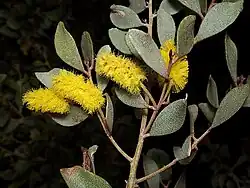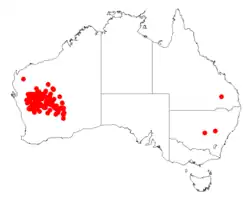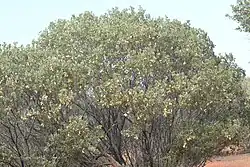Acacia craspedocarpa
| Hop mulga | |
|---|---|

| |
| Scientific classification | |
| Kingdom: | Plantae |
| Clade: | Tracheophytes |
| Clade: | Angiosperms |
| Clade: | Eudicots |
| Clade: | Rosids |
| Order: | Fabales |
| Family: | Fabaceae |
| Subfamily: | Caesalpinioideae |
| Clade: | Mimosoid clade |
| Genus: | Acacia |
| Species: | A. craspedocarpa
|
| Binomial name | |
| Acacia craspedocarpa | |

| |
| Occurrence data from AVH | |

Acacia craspedocarpa, commonly known as hop mulga[1] or broad-leaved mulga,[2] is a species of flowering plant in the family Fabaceae and is endemic to central parts of Western Australia. It is a dense, rounded or cone-shaped shrub with dark brown to black branchlets, elliptic to oblong, egg-shaped phyllodes, spikes of yellow flowers and stalkless, thickly leathery, winged pods.
Description
Acacia craspedocarpa is an erect, rounded or cone-shaped shrub that typically grows to 1–4 m (3 ft 3 in – 13 ft 1 in) high and about the same width, but occasionally a tree to 8 m (26 ft). It has sticky, dark brown to black branchlets with resinous ribs at the extremities. The phyllodes are elliptic to oblong or egg-shaped, occasionally almost round, 15–30 mm (0.59–1.18 in) long and 7–13 mm (0.28–0.51 in) wide with one to three main veins. The flowers are yellow and borne in a spike 7–20 mm (0.28–0.79 in) long in axils on a peduncle mostly 6–15 mm (0.24–0.59 in) long. Flowering occurs from March to September, and the pods are stalkless, thickly leathery to more or less woody, 40–60 mm (1.6–2.4 in) long and 15–30 mm (0.59–1.18 in) wide, yellowish to light brown, including a prominent wing 1.5–4 mm (0.059–0.157 in) wide. The seeds are more or less round, 8.5–10.5 mm (0.33–0.41 in) long and 7–9 mm (0.28–0.35 in) wide with a small, cup-shaped cream-coloured or pale yellow aril on the end.[3][4][5] The seed pods resemble those of the hop plant.[6]
Taxonomy
Acacia craspedocarpa was first formally described in 1887 by Ferdinand von Mueller in the The Chemist and Druggist of Australasia.[7] The specific epithet (craspedocarpa) means 'edge-fruited', referring to the broad, marginal wing of the pods.[3]
Distribution and habitat
Hop mulga is endemic to arid and semi-arid areas in south-central Western Australia where it grows in, and along watercourses, in loamy or clayey soils between Byro Station and Yalgoo in the west and Wiluna, Laverton and near Kalgoorlie in the east, in the Gascoyne, Little Sandy Desert, Murchison and Yalgoo bioregions of Western Australia.[1]
Conservation status
Acacia craspedocarpa is listed as "not threatened" by the Government of Western Australia Department of Biodiversity, Conservation and Attractions.[1]
Use in horticulture
The ornamental medium to tall plant is available commercially and grows well drained light to heavy soils in full sun or partial shade and is drought tolerant once it is established. It will also tolerate a light frost to around −8 °C (18 °F) It is quite long lived and can grow well in a container.[2]
See also
References
- ^ a b c "Acacia craspedocarpa". FloraBase. Western Australian Government Department of Biodiversity, Conservation and Attractions.
- ^ a b "Acacia craspedocarpa". Australian Native Plants. 2020. Retrieved 2 May 2020.
- ^ a b Maslin, Bruce R.; Pedley, Leslie. Kodela, Phillip G. (ed.). "Acacia craspedocarpa". Flora of Australia. Australian Biological Resources Study, Department of Climate Change, Energy, the Environment and Water: Canberra. Retrieved 31 July 2025.
- ^ "Acacia craspedocarpa". WorldWideWattle. Western Australian Herbarium. Retrieved 2 May 2020.
- ^ "Acacia craspedocarpa". Australian Biological Resources Study. Retrieved 31 July 2025.
- ^ Mitchell, A. A.; Wilcox, D. G. (1994). Arid Shrubland Plants of Western Australia, Second and Enlarged Edition. University of Western Australia Press, Nedlands, Western Australia. ISBN 978-1-875560-22-6.
- ^ "Acacia craspedocarpa". APNI. Retrieved 30 July 2025.